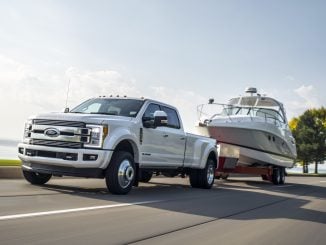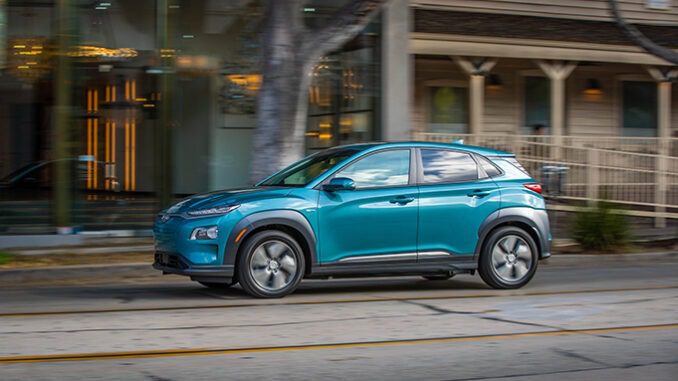
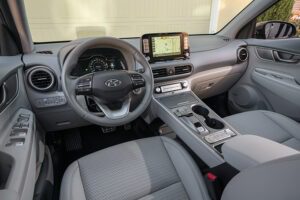 SAN DIEGO — When you ask most “regular” people about electric cars, they’ll inevitably mention Tesla. And with good reason; Elon Musk (currently the world’s wealthiest person) has done more for the electric vehicle (EV) movement than anyone and Tesla cars are what comes to mind for just about everyone when the topic of EVs comes up.
SAN DIEGO — When you ask most “regular” people about electric cars, they’ll inevitably mention Tesla. And with good reason; Elon Musk (currently the world’s wealthiest person) has done more for the electric vehicle (EV) movement than anyone and Tesla cars are what comes to mind for just about everyone when the topic of EVs comes up.
Of course, electric cars still make up just a fraction of total sales even if Tesla produced a half-million cars worldwide in 2020. But most carmakers are making “battery electric vehicles” that don’t take any traditional fuel at all these days, including my review car this week: the Hyundai Kona Electric.
Hyundai is absolutely killing it these days, making well-built cars that are handsome inside and out and with a 10-year/100k-mile powertrain warranty on all their vehicles — on top of a 5-year/60k bumper-to-bumper warranty. That’s way more than you get from Honda or Toyota, which is a big deal for a budget-conscious buyer.
I reviewed the regular Hyundai Kona last year and loved it — it’s the Korean carmaker’s remarkably well-equipped subcompact crossover and it also comes in an electric version which is totally different in powertrain and yet the basically the same everywhere else.
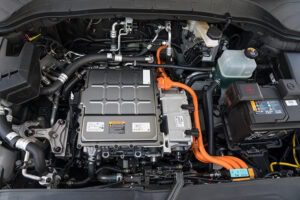 The Kona Electric swaps the 1.6-liter turbocharged four-cylinder for a 201-horsepower all-electric powertrain with a 64-kilowatt hour battery pack that’s good for an EPA-estimated range of 258 miles. The EPA-range on EVs tends to be a pretty fair guess in my experience, and it was with the Kona, too.
The Kona Electric swaps the 1.6-liter turbocharged four-cylinder for a 201-horsepower all-electric powertrain with a 64-kilowatt hour battery pack that’s good for an EPA-estimated range of 258 miles. The EPA-range on EVs tends to be a pretty fair guess in my experience, and it was with the Kona, too.
If you get one (as with any electric car), you’ll want to get what’s called a Level 2 charging station in your garage from a company like ChargePoint or Clipper Creek. It takes way too long to charge off a regular 110-volt home power outlet and it’s not good for safety to do that regularly either, so call your electrician. You should be able to get one installed for under $1,000 depending on local permitting requirements and your home.
But once you do, that Level 2 home charger should be able to fill the Kona Electric up from empty in about nine hours — in other words, charge it at night and you’ll always be ready to go.
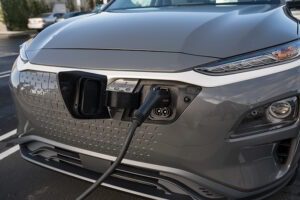 It also has a high-speed “DC Fast Charging” system on board with an SAE Combo port that would let you charge up really quickly if you’re on a road trip. Like everything, there are some format wars in electric vehicles too and if you buy one, you’ll start to become familiar with them. Still, there are plentiful apps to help you locate chargers and a properly equipped DC fast charger should fill the battery up to 80 percent in 30 minutes or so.
It also has a high-speed “DC Fast Charging” system on board with an SAE Combo port that would let you charge up really quickly if you’re on a road trip. Like everything, there are some format wars in electric vehicles too and if you buy one, you’ll start to become familiar with them. Still, there are plentiful apps to help you locate chargers and a properly equipped DC fast charger should fill the battery up to 80 percent in 30 minutes or so.
Even better, the fast charging networks are growing incredibly rapidly and it’s not nearly as difficult to charge on the go as it used to be. Many are located on major interstate routes, including all over North Carolina.
EV tech aside, the Kona is remarkably like a regular vehicle. It doesn’t look weird (aside from the solid front end because of the lack of a radiator and that’s where the charging port is), and it’s just like a normal car on the inside. It’s literally the regular gas-powered Kona, but with an electric motor swapped in.
This is a nice thing, actually. Many EVs look weird or operate weird or don’t have an on/off switch or because they want to showcase how futuristic they are. That’s all well and good, but many people just want a car where they can get in, start it, and drive off without having to think too much about it.
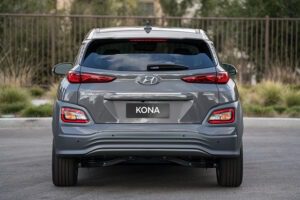 The only thing you need to know about the Kona Electric to drive it is that there’s a paddle on the left side of the steering wheel to adjust the regenerative brake level. Electric cars can recharge the battery under braking (it’s why they’re so efficient), and you can use that paddle on the wheel to change how much the car slows itself down when you let off the accelerator. If you put it on its most intense level, you can effectively drive with one foot — on the accelerator to go or take your foot off to slow down to a stop.
The only thing you need to know about the Kona Electric to drive it is that there’s a paddle on the left side of the steering wheel to adjust the regenerative brake level. Electric cars can recharge the battery under braking (it’s why they’re so efficient), and you can use that paddle on the wheel to change how much the car slows itself down when you let off the accelerator. If you put it on its most intense level, you can effectively drive with one foot — on the accelerator to go or take your foot off to slow down to a stop.
It becomes second nature pretty quickly, but if you want it to act like a more “traditional” car, it’ll do that too — which is particularly nice if you’re loaning the car to someone not so familiar with EVs.
As a day-to-day car, the Kona Electric is near-perfect, aside from the as-tested price of $46,430. It is eligible for a $7,500 federal tax incentive and it can use North Carolina HOV lanes regardless of the number of occupants. A similarly equipped gas-powered version can be had for less than $30,000.
But if you want a car that’s better for the environment, or just want to impress your friends with something they probably haven’t seen before, the Hyundai Kona Electric is well worth a look.


